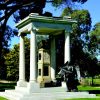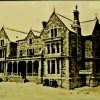Euphemistically and eulogistically described as the ‘Father of South Australia’, George Fife Angas still speaks to us through the church bells of Adelaide each Sunday. Equally, we are sometimes reminded of him by a bung of ‘fritz’ or a glass of Barossa shiraz.
The most comprehensive biography of Angas was published in 1891 by Edwin Hodder. His view is generally regarded as overly magnanimous, but Angas rightfully ranks with Colonel William Light, Colonel Robert Torrens, Edward Gibbon Wakefield and Robert Gouger in a quintet of influence and power which ensured that the great experiment in systematic colonisation would be realised. They are the most important ‘founders’ of the province of South Australia, first formally settled by Europeans in 1836.
Born of Scottish Presbyterian ancestry into a then devout non-conformist Baptist family in Morpeth, Newcastle, in 1789, Angas rose to be a successful coach builder, ship owner, merchant and banker in early-nineteenth century London.
In a strange confluence of circumstances he became associated with the Wakefield-inspired movement to settle a new colony, where the purchase of land was to fund the emigration of labour; where men of capital could build pastoral wealth; and where the separation of church and state might provide unencumbered freedom of religious expression. These principles did lead to a ‘City of Churches’ and a diffusion of small, mutually exclusive congregations throughout the vast hinterland of South Australia.
In 1900 there were arguably more churches in Adelaide and each small town in South Australia than anywhere else on the planet. Each small group of brethren, sect or congregation had built a little temple to God and often with financial and philanthropic assistance from the Angas family. George Fife was a person with a deeply religious rudder. He has been variously described as parsimonious, pious, sanctimonious, philanthropic (especially in the name of Jesus Christ), capitalistic, visionary, solipsistic, intensely driven, opportunistic, prudent, occasionally speculative, fiercely anti-papist (at least in his earlier years), non-conformist, conservative – and stubborn.
In South Australia, he is usually remembered for two history-making achievements. Firstly, the financial rescue package he organised through the auspices of his newly formed South Australian Company and which secured a start for the colony when he was a member of the South Australian Colonization Commission. Secondly, his personal sponsorship of large numbers of German religious dissidents from Prussia to the now famous wine-producing precinct of the Barossa Valley and elsewhere.
From the outset, the British Parliament had been reluctant to support the South Australian Association’s colonisation proposal unless it was financially self-sustaining, and when the idealised project faltered for lack of subscriber support, Angas and his non-conformist contemporaries stepped into the breach. He and the other Christian directors purchased £35,000 worth of the remaining land orders from the South Australian Colonization Commission at a 40% discount (twelve shillings per acre) and immediately formed what was to become the highly successful South Australian Company. Despite a shaky start it flourished until the middle of the twentieth century.
The Barossa Lutherans fortuitously owe their existence to both George Fife and his brother, William, who became a multilingual Christian missionary in Europe until his death in 1832. William Angas, with strong financial and spiritual support from brother George, led missions to seamen and ministrations to many European religious communities in Germany, Holland, Norway, Sweden, Russia and France. Unsurprisingly therefore, Pastor Kavel and his aggrieved group of Lutheran faithful sought the help of George Fife Angas in London, and at great personal expense he advanced (with interest to be paid later) sufficient monies for the estranged community to emigrate to ‘the land of promise’. As a result, these Klemzig, Hahndorf and Barossa Lutherans were among the first peoples of Europe to receive formalised ‘religious asylum’.
Never one to sit and dream, George Fife Angas had an insatiable appetite for work. He was a reputable merchant and ship owner in London for more than forty years before he emigrated in 1850 to South Australia, aged 60.
In London he presided as Chairman of directors over a number of powerful companies including the National Provincial Bank of England, the South Australian Company, the Bank of South Australia and the Union Bank of Australia. Earlier he had assumed the mantle of his father Caleb’s successful coach-building business and extended the family fortune by commissioning his own ships to import quality mahogany timbers from British Honduras.
He became a strong advocate for the abolition of slavery and a staunch supporter of William Wilberforce, Thomas Fowell Buxton and other social reformers. With distaste for the practice of transportation, a missionary zeal to convert all to Christianity and an abiding contempt for immoral excesses, especially among sailors, he set about putting the world to rights. With the secretarial assistance of his two daughters, who kept track of all his paperwork, he produced numerous letters, pamphlets and articles in support of many religious and social causes.
In 1822 he became president of what became known as the Newcastle Seaman’s Society, and by 1824 he was an active member of the British and Foreign Seaman’s Friend Society.
Angas was a dissenter and a Whig and he was independently asked to run for Newcastle, Sunderland and Pontefract electorates in the run up to the Reform Parliament of 1832. He declined. John George Shaw Lefevre from the Colonial Office asked him again in 1836. He declined again, for by then he was consumed by an overwhelming interest in the new colony.
By 1832, Angas was offered a copy of the prospectus for a proposed South Australian Land Company, and offered to take up enough shares to warrant a directorship. Among his preconditions were: authority for the company to appoint a Governor; a promise that ‘Bible truth was to be given unfettered expression without any State Aid’ or interference; no paupers; and a Legislative Assembly. The proposal failed for lack of support from the Colonial Office and Angas withdrew from the scene with a heightened repugnance for public servants.
However, in 1835, when Robert Gouger and others finally succeeded in bringing the South Australia project to fruition, Angas was offered a seat on the board of the South Australian Colonization Commission, on which he served with distinction until relinquishing it preparatory to the formation of the South Australian Company.
It was the honourable thing to do, but unsurprisingly he extracted from the Commission the very best of commercial terms on his exit. These included long leases of land on fair terms, the sequestration of coastal land needed for whaling, contracts for the sale of salt beef, pork, whale oil and fish, and most significantly an agreement by the Commission to allow the sale of Special Surveys, each of 4,000 acres, to large investors.
In 1836, the Wakefield experiment became a reality and Angas immediately sent company ships to Kangaroo Island, where his men established a base ahead of all Commission parties.
For the next decade George Fife Angas wielded the most amazing power over the colonial project, especially from Dawlish, in Devon, where he had moved to repair his health. He travelled from village to village, recruiting hundreds of immigrants from the pulpit, and between 1837 and 1839 chartered numerous ship loads of emigrants from all over Britain but principally from the south-west.
The population in Adelaide rose quickly to several thousand, but by 1840 Angas had become bitterly disappointed, especially when the government disbanded the South Australian Colonization Commission, stripping it of its autonomy and removing some of the conditions under which the South Australian Company had taken up land.
Instead of tapping the Emigration Fund to send out the required number of labourers for each land grant, this feature of the original Act was dishonoured. Consequently, the flow of immigrants all but dried up between 1840 and 1843 and the colony fell into its first deep economic depression. Angas was bitter about this and began a concerted letter-writing campaign on behalf of the colony, admonishing the government at every turn.
Eventually, the colony recovered financially, especially after minerals were discovered at Kapunda, and Angas decided to emigrate. He sailed into the Port River aboard the Ascendant on 15 January 1851, his chest swelling with pride as he alighted onto McLaren Wharf. In a seamless introduction to power and influence in the colony he took the reins of the family pastoral enterprises at Lindsay Park and assumed a seat in the Legislative Assembly, which by 1857 had become an expression of ‘responsible government’.
His last thirty years were benign and he was blessed with great wealth and a mellowing sense of security, although in the parliament he had become staunchly conservative. His interest in the expression of religious freedom never waned, and he and his family gave generously to many denominations and religious causes from then on.
George Fife Angas died in 1879 with an estate worth £443,000. He was 90. His passing was momentous in Adelaide, and in Britain several newspapers noted his death.







Comments